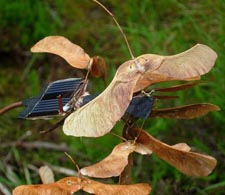
Robin Ripley, Alate.
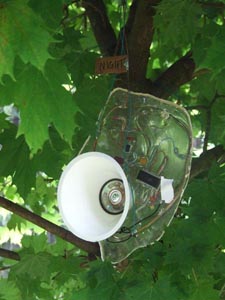
Diana Burgoyne, Audio Pools.

Lori Weidenhammer, Weidenhammer's Sonic Therapy Spa.
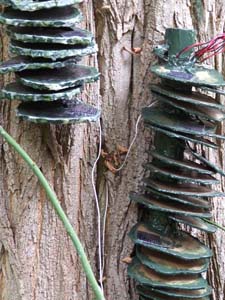
Peter Courtemanche, Poison Mentor.
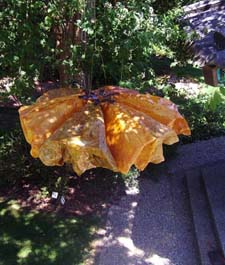
David Floren, Diaspora.
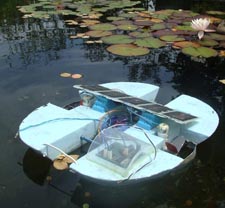
Matt Smith, Pondering
2 0 0 9 |
Second Site II – Robots in the Garden
by Kate Armstrong, December 18, 2009
Featuring works by Diana Burgoyne, David Floren, Matt Smith, Robin Ripley, Peter Courtemanche and Lori Weidenhammer, Second Site was on view at Van Dusen gardens in Vancouver, Canada, throughout the summer of 2009. The exhibition presents robotic sculptures that inhabit the garden alongside plants and animals.
Some of the work examines themes of technology, temporality and the cycles of nature. For example in Alate, Robin Ripley examines natural cycles using the forms and site-specificity of the garden's formidable maple grove. The work takes maple "keys" – the winged seed cases produced by maple trees – and integrates them into constructions, including long vertical spirals and ladders, with motors and copper tubing. Powered by solar panels, the motors agitate the delicate constructions of maple keys in different patterns at different times in the day.
Like many in the show, the scale of this work is subtle and the project seems to consciously avert spectacle. The works are often small or delicately immaterial, blending with the surrounding plant architectures, placing a quiet responsibility onto the viewer who must find the works within the large, leafy and highly complex visual context of the garden.
A major contribution of this show is that it poses questions about the role of human understanding in relation to complex patterns within technological and natural systems. In addition to the challenging and specific context of the site, this is achieved by the works in the show that take imperceptible modes or effects and make them visible or audible.
One example is Diana Burgoyne's Audio Pools, which collects and replays soundscapes from the site of a maple tree. Visually the artwork consists of a white cone with a clear resin outer ring embedded with copper wires and custom circuitry. The construction hangs from the branches of a maple tree and is powered by solar panels mounted in the tree's canopy. Two dangling pennies allow viewers to activate the work: pinching them together spurs the audio to play sounds from one of four time periods – night, dawn, dusk or mid-day.
The work builds upon the organic structure of the tree, creating an opportunity to replay moments from the sited experience of the tree. It quietly brings to mind the age-old riddle about observation and reality: If a tree falls in the forest and no one is there to hear it, does it make a sound? In this work we are able to play back the sonic experiences of the tree – to in effect re-experience moments from the life of the tree, irrespective of human presence.
Another example of the way imperceptible patterns can be made visible or audible is Weidenhammer's Sonic Therapy Spa by Lori Weidenhammer, in which passersby are invited to sit in a lawn chair and listen to a "dynamic tone chord" created by honeybees mixed with tones generated from currents in the earth.
The effect is fugue-like, a scale with notes moving down at intervals: it is cultivated, meditative, beautiful, aesthetic yet unfinished, algorithmic, raw. The impression is one of listening to the earth and the patterns of things on the earth.
An alternate approach to sonifying invisible patterns of activity can be found in Poison Mentor by Peter Courtemanche, in which a "sonic tree fungus" monitors environmental radiation. This reflective black lump attaches to the trunk of a tree near VanDusen's Korean pavilion and detects patterns of radiation from sources in the immediate atmosphere such as radio and cell phones. The sounds of this radiometric activity are played back through a speaker.
It is not an alien sound but a familiar one, scratchy, variable, with electronic tones and clicks like an old modem, a record player scratching and a long distance telephone call combined.
The work implies a strange realism in the sense that this array of sounds are in effect the natural sounds of the landscape. By carrying mobile telephones in the garden, the audience creates radioactive traces that are detected by the fungus. Sited in VanDusen gardens within the large city of Vancouver, electrical fields powerfully but invisibly surround the pastoral enclave. What would the garden sound like if we as a culture were free of electrical activity? It becomes a philosophical riddle about subjective knowledge, inviting reflection on our inability to transcend our technological and social conditions. These are the sounds of culture. These are the sounds of nature. Together we create this landscape. Without us it would be different, but how could we know?
Another angle on the role of human understanding in relation to technological and natural systems that is explored through the works in this show is the idea of mirroring things we don't see, and reflecting on things we miss.
Take David Floren's Diaspora, a hanging amber seed-pod powered by solar engines which releases its seeds in response to wind and sun conditions. It is one of the most visually striking pieces in the exhibition – large, lush and papery, and yet because the essence of the work is the event, built into the idea is that something will be either witnessed or missed. The possibility exists that when you happen upon Diaspora, the seeds will have flown. It is within the nature of the human subject to occupy only a single point within a larger fabric of occurrence – much happens when we are not there.
Conversely, rather than the single, dramatic event that we are there to witness or that we miss, leaving us to try to piece things together, Matt Smith's Pondering presents us with a floating reflection of a hidden, but banal, landscape.
Pondering is a robotic boat, a roving eye that floats alongside lily pads in one of the garden's ponds, recording what it sees on the bottom of the pond. The boat itself barely disrupts the water's surface; the underwater footage recorded by the boat is cloudy and at first looks like the sky. Recalling both a paddle boat and a Roomba, Pondering suggests reflection: The boat seems to reflect on the landscape mechanically, by taking the light of the sun and turning it into slow but methodical movement across the water, producing a portrait of the hidden underwater reach.
The boat makes an ongoing physical path or map that translates into a long linear video stream of what is underneath the water's surface. Through the pace of the boat and the endlessness of the implied video, there is a feeling of languid, undirected activity, of slow and ongoing exposure to natural phenomenon, like a long, slow hike. The boat is lazy, hopeful, vacant: it shows us something normally hidden from vision, but rather than opening up some sublime vista the view of the underwater landscape is abstract, banal.
∼
The exhibition raises questions on perspective, context, connection, and subjectivity. Do plants possess subjectivity? Do robots? Are the things we don't see as real as the things we do see? What is the role of pattern, and does it change when we can detect it, whether or not we can translate it? Is it more surprising to find nature in technology or technology in nature?
Do these robots in Second Site mock, mimic, or connect with plants in ways that we cannot know? Are they in effect mock plants? To look at it from the perspective of the plant world, we might postulate a plant asking, what is that thing over there?
Would a maple tree think of Floren's Diaspora as a monster or a doll, a film, a firecracker, or something different altogether, something simply "not-plant"? To a plant, does Diaspora possess the uncanny?
Similarly from the perspective of a robot – a different, non-art robot, a robot from the Jetsons, or the companion robot from Frederik Pohl's The Midas Plague. To this robot, would Robin Ripley's copper and maple key spiral seem leafy and pastoral? Would it be something to sit under, something to talk to, something to wear? Would Smith's Pondering be a figure in the landscape?
∼
What do robots and plants have in common? They are atmospheric, adaptive machines with strange protuberances, functions that are sometimes alien to humans, they have moods and seasons. They have been programmed into incredible patterns of behaviour that we sometimes recognize, and which sometimes we see but can't decipher even if we can appreciate other aspects. They are fragile and strong. They shock us with agency. They move and are part of systems. They are at once smart and dumb. They produce flashes of irritation and apathy as well as moments of beauty, metaphor and recognition.
And what is the position for humans in this? For a viewer who is neither a master gardener nor a robot genius, the position to plants and robots is a short distance. Sometimes we see function, sometimes beauty. Sometimes we are able to discern the patterns that create the behaviour of systems, most times not.
Just as I don't identify the functioning of each plant in the 55 hectares of VanDusen gardens, my impressions of the Second Site exhibition must be similarly impressionistic and accidental. It does not matter how the works function, only what the effects are. There are seed cycles, buttressing roots, and co-evolved relationships in the universe of a Ficus Elastica, but I see rubbery white flowers. There are "s" and "t" gates and antenna-tendrils from Poison Mentor, but I see bulbous shapes on the trunk and hear blended atmospheric noise. Both cause a doubletake.
It is an important show because a garden is something vital and living, fundamental, something we can appreciate and attend. To place these robotic artworks there makes us look again at the swirling layers of technology in culture – the data clouds, the fields, the clicks and drags, the scratches, the cameras, the reports, the bugs, the motors – and to ask again about the systems and relationships that define us. How can our technologies and systems intertwine with the technologies of the natural world, and how should they? How do we feel that there are robots in our garden?

Robin Ripley, Alate.

Diana Burgoyne, Audio Pools.

Lori Weidenhammer, Weidenhammer's Sonic Therapy Spa.

Peter Courtemanche, Poison Mentor.

David Floren, Diaspora.

Matt Smith, Pondering